The Devil Was in the Details for the Creators of ‘The Thing About Pam’

- Oops!Something went wrong.Please try again later.
Combining tragedy and absurdity in the same television show without diluting either aspect is a tall order. In that regard, NBC’s limited series “The Thing About Pam” achieves something extraordinary: It tells its true story with sensitivity and poignancy while simultaneously being raucous and hilarious. In bringing the stranger-than-fiction tale of Midwestern murderer Pam Hupp (Renée Zellweger) to life, the filmmakers combined scrupulous research with a meticulously crafted and psychologically expressive visual design to create a tone unlike anything else on television.
For showrunner Jenny Klein, the trick was juxtaposing Pam’s bizarre personality with an awareness of the real and immense pain caused by her actions. “We went into the show with the knowledge that we needed to balance this story that’s so disturbing and tragic with the totally absurd details that come from Pam’s over-the-top behavior,” she said. While Pam is the story’s focus, the series’ point of view is often that of her victims, which creates unique emotional effects as the audience is simultaneously amused by Pam’s brazen conduct, pained by its effects, and frustrated by the authorities’ unwillingness to acknowledge the truth.
More from IndieWire
“We wanted to honor the people that are at the heart of the show and the pain that they went through,” Klein said. “Of course it’s a dramatic retelling, but it’s based on real events and real people and we took that seriously.” Klein immersed herself in research before she began writing, and continued throughout production. “If anyone involved in the case or who knew Pam Hupp was willing to talk to the writers, we wanted to listen to their accounts,” she said. Klein and her team also had the benefit of a mountain of resources accumulated by NBC News Studios, who produced “The Thing About Pam” with Blumhouse Television and created the “Dateline” episode and podcast that served as the show’s source material. “That was a great treasure trove of material that we could use as our foundation,” Klein said.
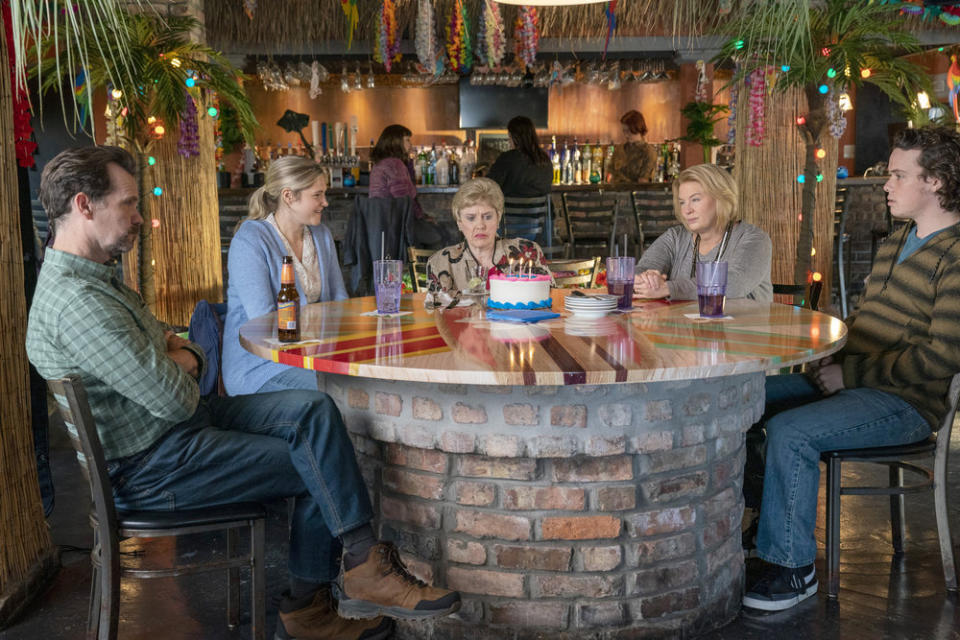
Skip Bolen/NBC
While the filmmakers pored over court transcripts and other documents, they also prepared in more personal ways that would allow them to get inside the story. Production designer Meghan Rogers, for example, traveled to the area where the real events occurred and went to local restaurants and stores to get a sense of how Pam and her neighbors lived and where they ate and shopped. She also found the three houses where Pam had lived in O’Fallon, Missouri, which gave Rogers insight into Pam’s nature. “The houses were all very close together, which told me she was a person of convenience,” she said. “From finding the houses I was able to discover the Dollar Tree she went to and the quick mart she was at all the time and other places she went, and all of that informed me about her pragmatic nature.”
Klein marveled at Rogers’ thoroughness. “She studied old real estate listings of Pam’s house and replicated every detail,” the showrunner said. “The harlequin wallpaper in Pam’s bedroom was really there, and so were the mounted deer head and the sunflower yellow foyer and the red and black hearts over her kitchen doorway. If anyone who knew Pam — or even Pam herself — were to watch the show, Meghan wanted them to say, ‘How did they know that? How did they get that so right?’ Rogers added that her intention was to keep the show from feeling curated or designed, and to that end she was as exacting as possible about sticking to the truth. “We looked at a lot of images to get a sense of what Pam’s style was and we stayed very, very true to that,” she said. “We didn’t want it to feel like a TV show.”
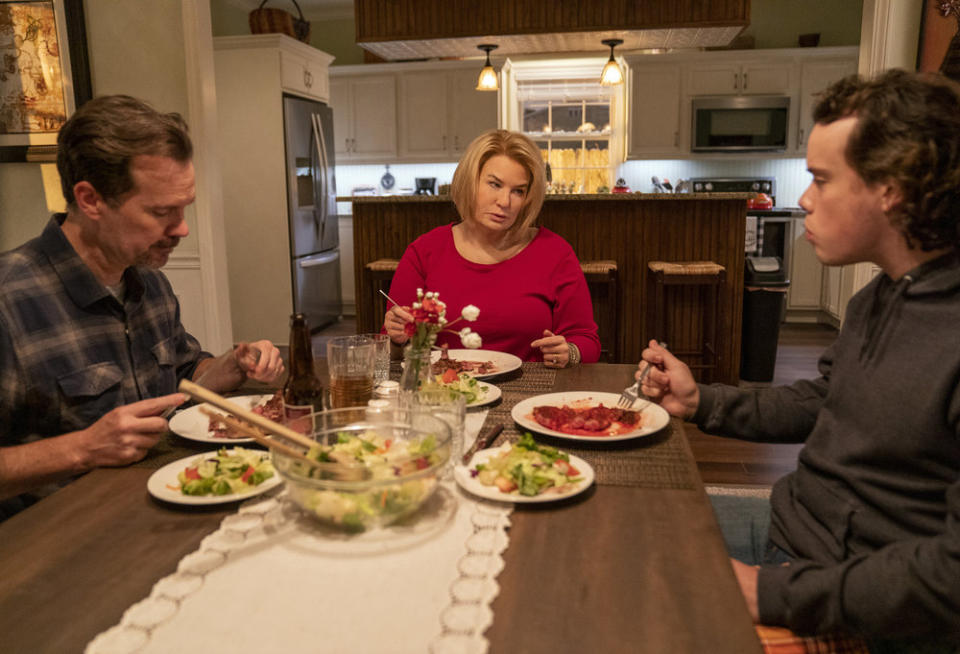
Skip Bolen/NBC
Cinematographer John Brawley, who collaborated closely with Rogers and costume designer Shawn Holly Cookson on the color palette, agreed that journalistic rigor was vital. “Normally you might choose colors that are prettier or more pictorially beneficial,” he said, “but because we were representing real people and the tragedy of real murders, it was important to be as accurate as possible. We didn’t want things to look too polished or artificial. If the wall color that existed wasn’t the best color for the skin tones, we went with it anyway.” Brawley felt that adhering to reality served not only a moral but a dramatic purpose, making it easier for the audience to understand how Pam hid in plain sight. “It’s what’s kind of amazing about this story, and we wanted to show how that was possible without adding any artifice.”
Of course, the key to telling Pam’s story was ultimately the characterization of Pam herself, brought to life by an extraordinary performance and an array of skilled artists. Like everyone behind the camera, Zellweger delved into the materials of the real life case to develop as complete an understanding of Pam as possible, and her role as a producer on the series further enhanced her performance thanks to the conversations she was able to have with all of the departments. “There’s constantly new information that comes in about things you wouldn’t necessarily think to research or ask questions about,” Zellweger said, “and all of that makes it much easier to tell the story as accurately as possible.”
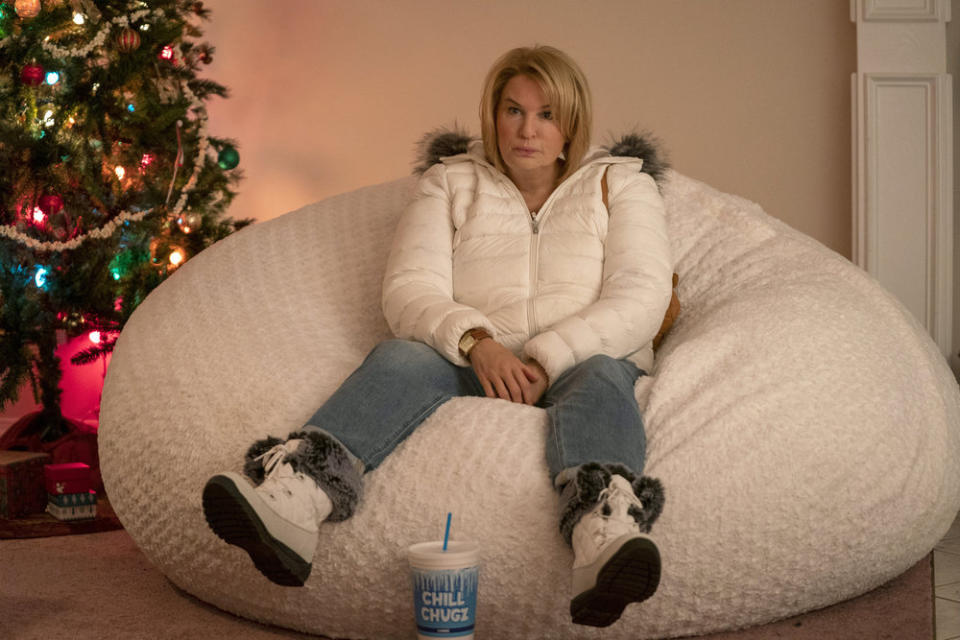
Skip Bolen/NBC
While the strength of Zellweger’s performance comes largely from her ability to transmit the inner life of a narcissistic sociopath, the external aspects of the character are equally remarkable and represent a seamless integration of Zellweger’s transformative gestures, voice, and body language with top-notch work from the hair, makeup, and costume departments. One of her essential collaborators was special effects makeup artist Arjen Tuiten, who designed Zellweger’s prosthetics. “It was pretty magnificent what he was able to do,” Zellweger said. “He was able to create an approximation of the real Pam that was as representative of her as possible without taking it so far that it became distracting.”
Tuiten returned the compliment by describing Zellweger’s commitment to the process. “Some actors underestimate how much time and work it requires to build something that looks realistic and believable,” he said, “but from our first Zoom meeting I could tell that Renée understood what it was going to take and we instantly hit if off.” For Tuiten, that trust and camaraderie was paramount. “I’m with the actor for 14, 16 hours a day, so if there’s not mutual respect it’s just not going to work.” Zellweger added that Tuiten’s care for his work gave her total confidence in their collaboration. “He built each piece by hand and painted them by hand, down to every freckle and mole and indentation,” she said. “He built every smile line and everything else carefully into the prosthetic every day.”
Zellweger’s performance in “The Thing About Pam” raised the bar for everyone else on the show; Klein and casting director Terri Taylor had to populate the series with exceptional actors from top to bottom to keep the supporting characters from being blown off the screen. Luckily, Zellweger was surrounded by a pitch-perfect ensemble cast that included Glenn Fleshler as the man wrongly accused of Pam’s first murder, Josh Duhamel as his defense attorney, and Judy Greer as the overzealous and myopic prosecutor. While their physical transformations may not have been as drastic as Zellweger’s, all of these performers worked carefully with various department heads to alter their appearances with fidelity to their real-life counterparts.
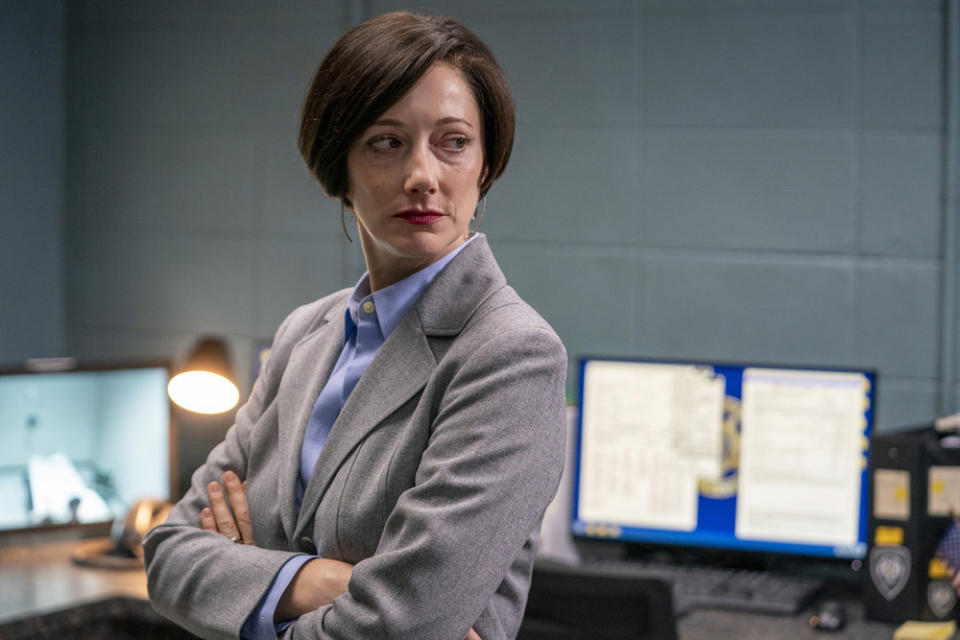
Skip Bolen/NBC
“Each and every one of these actors was down for whatever,” makeup department head Carla Brenholtz said. “There wasn’t any complaining that they didn’t look good or wanting to keep their sexy scruff. Josh shaved his sexy scruff and was happy to do it!” In Greer’s case, the actress opted for dark contact lenses and a dark wig and lipstick to change her appearance and get closer to the real Leah Askey.
Brenholtz echoed Tuiten’s sentiments about mutual trust: “When you turn on the television, you don’t really see Judy Greer, and you don’t see Renée, and I really attribute that to the actors letting us do our jobs and allowing us to create their looks through research,” she said. “Our biggest job is not putting the makeup on the actors’ faces. Our biggest job is creating a comfortable environment for them in the morning, a trusting space where they leave us feeling confident that they are the character. I don’t want them to ever feel like they have to look in a mirror, because if you have to keep asking for a mirror you don’t remember your lines, you don’t remember your marks.”
Hair department head Lawrence Davis shared Brenholtz’s respect for the actors and her belief in authenticity as a guiding principle. “The first thing I do when I get a job is head to the internet and find out everything I possibly can about that particular story and characters,” he said. “I want to reference everything that’s out there, whether it’s a news article or photographs or whatever else happens to be floating around.” In Duhamel’s case, Davis worked with the actor to create a wig that would accurately replicate the hair of the real life Joel Schwartz and get Duhamel where he needed to be to turn into that character. “Suggesting a wig or a particular color or haircut always provides opportunities for actors to disappear and cover themselves in the character. It just helps them to get there and stay there and make it as real as possible.”
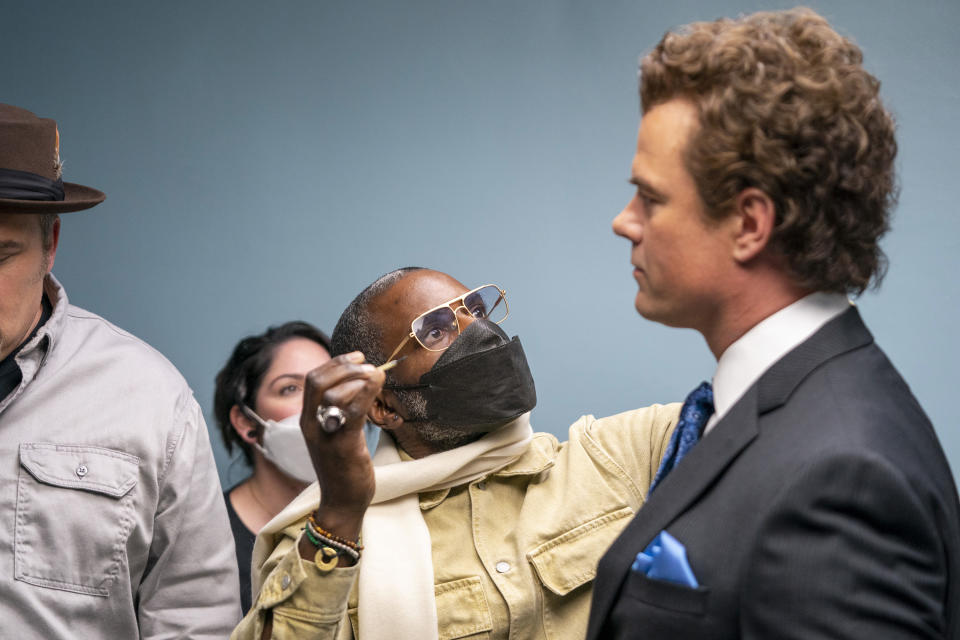
Skip Bolen/NBC
Cookson was another essential partner for Duhamel and the other actors when it came to fleshing out their characters, and once again research provided the foundation. “There was no glamorizing, I just tried to make the clothes as accurate as I could,” Cookson said. For Duhamel, that meant creating suits that were slightly ill-fitting, since that was the way Schwartz wore his clothes in court. “When Josh came in, I told him that he was going to have to put on a kind of swagger because the suits didn’t really fit him, yet Joel was kind of a rock-and-roll guy — he was not at all uptight.” Cookson explained to every actor that “The Thing About Pam” would be as down and dirty and realistic as possible, even if that meant Cookson going against her own instincts. “I’m a perfectionist, so if a hem is off or a sleeve is too long it really bothers me. It was really challenging for me not to perfect everything!”
An added challenge was the fact that “The Thing About Pam” takes place around 10 years ago, in a recent past with many small differences from the present day that need to be addressed. “You need to pay attention to that,” Cookson said. “You can’t just throw stuff on that’s from the present day.” From a production design standpoint, doing a recent period piece was more difficult than designing something set further in the past. “It’s harder because the differences aren’t obvious,” Rogers said. “They were still using landlines a lot, for example, and social media was beginning but not as prevalent as it is now. And these are people who don’t always stay up with the times — they take care of their stuff and keep their home items and don’t buy the new thing every other week. So we rolled it back a few years before 2011, more to around 2005.” The attention to detail is evident in every scene, and the cumulative effect is undeniable — it’s hard to think of another series that so truthfully captures its time and place.
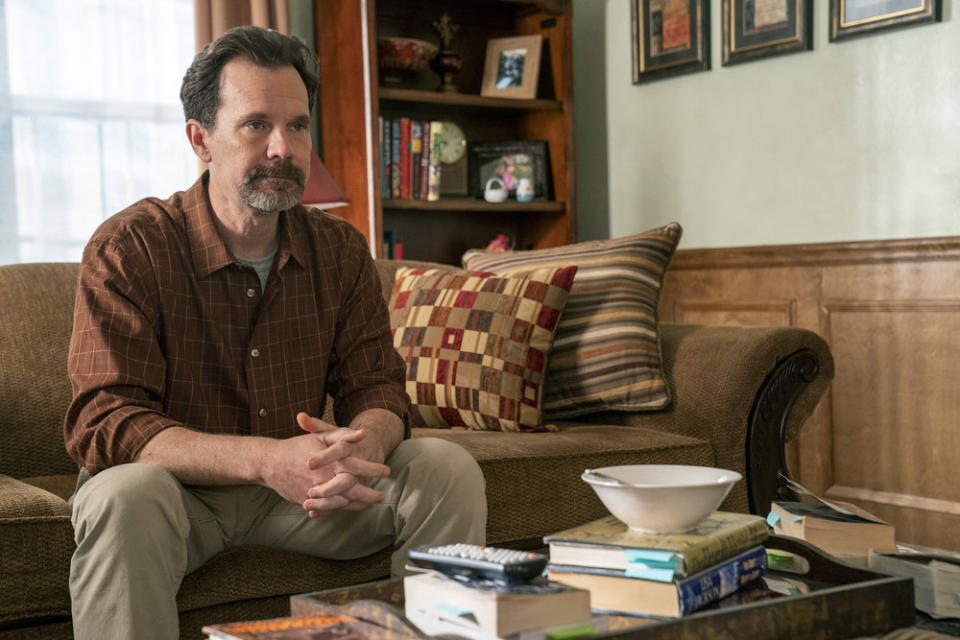
Skip Bolen/NBC
Yet what’s remarkable about “The Thing About Pam” is that the re-creations coexist with a painstakingly deliberate and highly artistic style that subtly but powerfully conveys feelings and ideas that were inaccessible to the “Dateline” producers. In her use of color, for example, Rogers hit on a pivotal idea. “The metaphor for Pam was that she lived her life as an opportunistic hunter,” Rogers said, “so the tones in her house are based on camouflage colors. I called it the prismatic color wheel of beige.” By contrast, in homes like the one belonging to the mother of Pam’s first victim, Rogers used pink, mauve, and a general potpourri blend of colors to make it feel warm and inviting.
One of the more subtle but effective uses of color comes in the show’s use of blue, the color of the convenience store cups Pam constantly slurps from and one which carries psychological connotations throughout the series thanks to its direct association with Pam. “Every time we see one of Pam’s victims for the first time there’s a bright blue color somewhere in the scene with them,” Rogers said. “Then, as Pam becomes a victim of her own lies her world gets more cool and blue until she finally winds up in a bright blue prison — a prison of her own making.” The blue motif not only imprisons Pam but creates a subliminal and extremely effective sense of dread in the audience — as we watch the show we feel uneasy even in scenes Pam isn’t in. Riding the line between that kind of graphic impact and the show’s more documentary impulses was the result of careful collaboration between Klein and all of her departments. “We wanted the show to feel like a less heightened version of a graphic novel, where the elements of every panel are working in concert,” Klein said. “It was really important for all of us to be on the same page to create that kind of visual cohesiveness. The idea was to depict a suburbia where something really insidious is going on beneath the surface.”
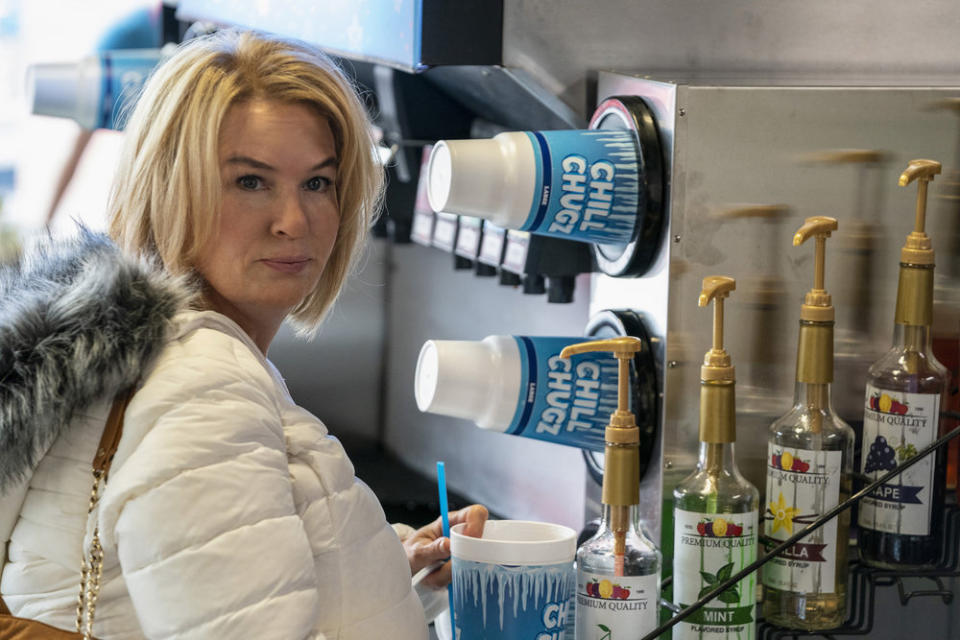
Skip Bolen/NBC
The filmmakers were able to cut loose in later episodes of the show depicting events from Pam’s completely skewed perspective via scenes that Rogers and Brawley referred to as “Pam visions.” “By the time Pam has finished a sentence, she’s often contradicted herself four times,” Brawley said. “Her verbiage is so impenetrable that you really can’t comprehend what she’s saying.” As Pam’s stories get more exaggerated and contradictory, the visual style becomes more theatrical and jagged, employing split-screens and artificially manipulated sets and space to create what Klein refers to as “a cinematic portrait of a liar.” It’s in sequences like the Pam visions that “The Thing About Pam” not only sets itself apart from other crime series but wholly justifies its existence alongside the “Dateline” episodes and podcast that covered the case so extensively.
The final step in creating the show’s distinctive tone and sophisticated relationship between the audience and its story is in the editing, which is extremely delicate in its presentation of its indelicate title character. For Aric Lewis, who edited episodes three and six, one challenge was calibrating how obvious Pam’s lies were at any given moment, since the progression of the series follows her as someone who is initially believed by many but ultimately believed by virtually no one — even though she’s blatantly lying the whole time. “If we’re on Pam and it’s ‘real’ — not a Pam vision — I’m always looking for smaller moments where Pam shows certain tics that come out when she lies,” Lewis said. “I might look for a sniff or an eye shift. Then in the Pam visions themselves, it’s about finding a balance so that the emotions don’t get too big or absurd.”
Lewis felt the same sense of responsibility as everyone else when it came to editing the piece. “The script tells me where to go, but knowing that these are actual events I have to keep in mind that this happened to real people,” he said. “I’m trying to make something that’s entertaining without making light of it. I don’t so much want you to have fun as be unable to look away because you can’t believe what you’re seeing.” While for the viewer “The Thing About Pam” is undeniably “fun” at times thanks to the sheer pleasure of the craftsmanship and the infectious joy the actors take in their performances, one can feel the gravity of the source material behind every scene, a testament to the filmmakers’ seriousness. “Everyone tried to handle this with grace and integrity and honor the story,” Cookson concluded. “’Happy’ is a strange word to use, but I’ll put it this way: I’m glad that the story is out there.”
Best of IndieWire
The Best 30 LGBTQ Movies and TV Shows Streaming on Netflix Right Now
10 LGBTQ Film and TV Creators on the Rise, from Jerrod Carmichael to Isabel Sandoval
Sign up for Indiewire's Newsletter. For the latest news, follow us on Facebook, Twitter, and Instagram.

